
T-Shirts, bicycles or lamps… are we talking about art? And what does that imply?
A recent case concerning showcase lamps has led the German Federal Court of Justice to consolidate its understanding of the European concept of a copyright “work”. We take a look at its decision and the implications for design owners.
Introduction
The shape of a product can be protected by various IP rights, typically as a shape mark or a design. The latter is expressly defined as “the appearance of the whole or a part of a product resulting from the features of, in particular, the lines, contours, colours, shape, texture and/or materials of the product itself and/or its ornamentation” in Article 3 (a) of Regulation (EC) No 6/2002 of 12 December 2001 on Community designs. The outer appearance of (functional) everyday objects is therefore generally protected by the means of design law. But can this outer appearance of a (functional) product, such as a t-shirt, a bicycle or a showcase lamp, also be considered art and give rise to copyright claims? And what does that entail?
It is settled case-law of the Court of Justice of the European Union (CJEU), that the various IP rights overlap. The European legislator did not foresee a system where the existence of one right would exclude claims based on another IP right. For the delimitation between designs and copyright, the CJEU expressly held in Cofemel (C-683/17) that an object can be subject to copyright even if it also enjoys protection through design rights. The only requirement is that it fulfils the preconditions of copyright law. Therefore, any functional object (or rather its shape) can give rise to copyright claims at no other preconditions than other works of art. They must simply represent an original object, defined as the intellectual creation of its author, and be the expression of such a creation. But what does that entail for the infringement test?
In a recent judgment, the German Federal Court of Justice (FCJ) had the opportunity to consolidate its understanding of the European concept of a work and to confirm that the scope of protection of a possible copyright depends on the level of creation. (Federal Court of Justice, judg. of 15.12.2022, case I ZR 173/21 – Vitrinenleuchten.)
Background
The claimant, a lighting design studio, developed a sample of a new showcase lamp and registered the appearance of this sample as a design. A boutique purchased new showcase lamps from another manufacturer. The lamps sourced from the third party bared similar features to the claimant’s design.
Years later – and after its design had expired – the claimant sued the boutique for injunctive relief and damages based on an alleged copyright in the lamps. The Regional Court of Hamburg granted these claims in the first instance, which were however dismissed on appeal by the Court of Appeal of Hamburg. The Court of Appeal held that in any case, and irrespective of whether there was indeed a copyright for the lamps in question, the lamps sourced by the boutique did not infringe such a potential copyright.
- The low level of creativity of the design would result in a narrow scope of protection (at best).
- The lamps in question did not fall within the scope of protection as they differed (even if minimally) precisely in the elements that gave rise to copyright protection of the design in the first place.
Decision
The FCJ confirmed the Court of Appeal’s interpretation. It recalled that under settled case-law, both of the CJEU and the FCJ itself, works of applied art did not have to fulfil a higher level of creation or originality in order to enjoy copyright protection. All works were defined using the two cumulative conditions of an original being an intellectual creationand its expression. Works of applied art did not have to abide by other (stricter) principles. Furthermore, the scope of protection of works of applied art was not less than the one of other works. However, this did not imply that the scope of protection did not depend on the level of creativity, meaning that a narrow scope of protection followed from a low level of creativity.
The FCJ considered this interpretation “clear” from the existing case-law of the CJEU and did not consider it necessary to refer the case to the CJEU. The fact that the CJEU, in its Cofemel-decision, held that the legal standards regarding the scope of protection of a work apply equally to all categories of works, did not, in the view of the FCJ, preclude an interrelationship between the level of creation and the scope of protection of a potential work. Not everything in a work is in fact protected by copyright. When testing whether there was copyright infringement in this case, the FCJ only looked at the (few) free and creative choices which were not dictated by functional aspects, constraints or pre-known in the field.
Implications / Key takeaways
Copyright can be an efficient tool alongside design and competition law for enforcing claims against product imitators. It arises without any registration and grants a long period of protection. However, just because everyday objects enjoy copyright protection under the same conditions as other works, this does not automatically lead to a high scope of protection. It is necessary to carry out a precise examination of those elements of an object that establish copyright. Only these elements are subsequently assessed in the infringement proceedings. The lower the level of creativity (although sufficient to establish copyright), the lower the scope of protection – which can be limited to identical imitations.
Bird & Bird’s Munich office (Richard Dissmann and Laura Jones) acted for the successful defendant.








